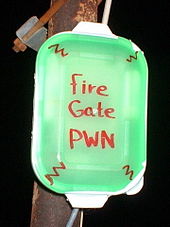Client mode
The client mode is a mode of wireless access points (APs), in which the relation to the parent AP as a wireless adapter behaves. With an AP operated in client mode, individual computers or entire subnets can be connected to higher-level networks.
Implementations
In addition to routers and APs, modern APs can also be operated as WLAN adapters in client mode. Alternative router operating systems can also be operated in client mode. See the Linux hardware router distributions OpenWrt , FreeWRT and DD-WRT .
comparison
In contrast to internal solutions such as PCI , PCMCIA or ExpressCard cards, in client mode the WLAN adapter can be positioned relatively independently of the PC , as with USB sticks . Antenna cables for WLAN antennas should not exceed 3 m in length, otherwise the signal level and the transmission rate may suffer too much. USB extensions can be up to 5 m long, but experience shows that extensions up to 15 m also work. With access points in client mode, the connection to the computer is via Ethernet cables, which can be up to 100 m long. In addition, several segments can be connected to one another with switches / hubs , which makes a multiple of the length possible.
Applications
With APs or routers in client mode, the usability of WLAN can be expanded by circumventing spatially restricted signal attenuation. A weatherproof packed router can also be installed outside of buildings and connected to a (low-voltage) power supply and a LAN with Power-over-Ethernet with just one (Ethernet) cable.
Demarcation
The client mode must not be confused with the bridging mode , in which two access points establish a wireless connection between two wired network parts.
